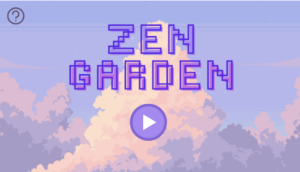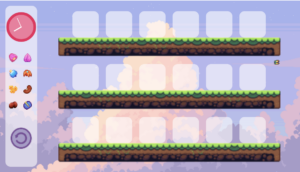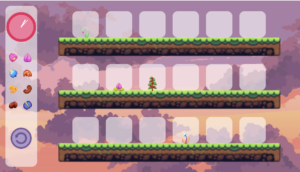Welcome to Zen Garden, a slow-paced experience where you are fully in charge of planting and growing each plant in the garden. Take a deep breath, enjoy the relaxing music, make butterfly friends and take pride in growing a beautiful garden.
Enjoy the experience for yourself here.
The Concept:
I wanted to create an experience rather than a game, since there is no winning or losing. That goes well with the intention of it being a relaxing experience, one which I and many of my peers need during weeks such as the midterms week. I wanted to create an experience where the user has control of what they plant, where they plant it, how many or few plants they want and at what stages they want to leave the plants at. The user controls how much the plants grow – with there being a final fully grown stage (which the user will be made aware by a celebratory sound).
Implementation:
I mainly used Object Oriented Programming to create this game, with my classes being Plant, Water and Butterfly. Within the Plant class are the different stages of a plant, the Water class is used to create individual droplets of water for watering the plant – and it utilizes a gravity() function to get them moving, and the Butterfly class has sprites and keeps track of where in the screen it is.
As for the other code, I had a few clever implementations which needed to be changed to simpler ones to optimize the code. I have a lot of get() functions and even more display() functions, since each item has its own methods for both of these.
In terms of user interaction, I only utilized mouse pressing and clicking. For all of the gameplay I used mouse pressing – regardless of if the user was pressing and holding (such as when they pick up the seed and hold onto it until they get to the planter), I just found that it worked better that way, and I only started utilizing mouse clicks to add sounds (which came at the end of my coding journey).
I use a lot of images for the graphics, but there are things which are drawn on P5, such as the play button, the clock and the white rectangles.
For the planters, I determined their locations and based on just coordinates I determine how many planters there are and where they are – I keep track of these using arrays. The graphics themselves are just a singular image for the whole thing – I initially coded in each block using loops but decided to optimize the code and removed the loops.
Challenges:
A lot of the challenges I faced was with how heavy my program was getting. I found myself needing to optimize my code and remove any loops which could somehow be avoided (such as the individual plots of land being replaced by one image).
The program is unfortunately still quite heavy because I wanted to utilize so many images and clicks, but other than the computer getting loud, it seems there are no problems reflected on the experience itself. I see it as a good compromise to have an aesthetically pleasing program with a lot of engaging sounds.
Another challenge which I realized too late is that the dimensions of the canvas might be a bit small to look at. A bandaid solution I would recommend if the dimensions bother you is to just zoom in on your browser – since the game graphics are intentionally pixelated, the quality will not be compromised much.
In terms of coding, it was quite challenging balancing events which happen at the same time. The draw() function can be quite tricky, since it loops so fast, I found myself jumping between the draw() function and other functions and utilizing a lot of boolean variables to set conditions and different states. After a lot of trial and error, as well as debugging (my most common line before cleaning up my code was probably console.log()), it all works at the end!



